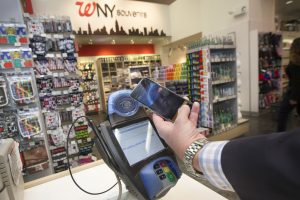Apple Inc.’s move to create a new Apple Pay credit card with Goldman Sachs Group Inc. may or may not help boost usage of the mobile-payments service, but one thing it is likely to do is cement Apple’s ties with the thousands of banks that support the service, observers say.
The pending Goldman deal “really encourages those [financial institutions] that have already committed to Apple Pay to really promote it,” notes Richard Crone, principal at Crone Consulting LLC, a San Carlos, Calif.-based financial-services consultancy. The alternative is to lose customers to the Goldman-Apple Pay card while remaining obliged for the contractual period to support their own cards in the Apple Pay wallet.
The result could be improved consumer adoption and usage for Apple Pay, and enhanced revenue flows for Apple, which collects a 0.15% share of the transaction amount on each Apple Pay credit card transaction (half a penny on debit). Already, Apple Pay has attracted 40 million U.S. users that Crone Consulting considers “active,” that is, making at least two transactions monthly.
By comparison, Google Pay and Samsung Pay, the wallet’s two main tech-based rivals, have 15 million and 11 million active users, the firm estimates.

Still, while Apple Pay has opened a wide lead over these rivals, some observers have been puzzled by what they see as the company’s shyness about promoting the wallet.
Details of the Apple-Goldman tie-up are not yet known, as planning is apparently ongoing. The cobranded product is not expected to hit the market until early next year, according to The Wall Street Journal, which broke the story on Thursday. But whether Apple Pay users stick with their existing cards or switch to the Goldman Apple Pay product, Apple stands to benefit. The computing giant could earn a 0.30% share of tickets under the Goldman deal, sources told the Journal. And it will collect a $100 bonus for each cardholder who signs up, those sources said.
Neither Apple nor Goldman responded to requests for comment from Digital Transactions News.
Apple has turned to Goldman after years of supporting a cobranded card with Barclays PLC. The new card, however, will carry branding specific to Apple Pay, which Apple launched in the fall of 2014 as a mobile wallet that depends on near-field communication for point-of-sale links and stores card credentials in a phone-based secure element. The Barclays card, too, features contactless as well as EMV capability.
The Barclays deal was due for rebidding, a process Goldman apparently won, according to Crone, who says Apple may well claim an even larger share of issuer interchange than the Journal report indicates. “I think it starts around two-thirds for Apple,” he says. “If not two-thirds, then they will get a cut of the financing and other fees.”
Meanwhile, financial institutions already supporting Apple Pay could face a stark choice: stick with the wallet, and possibly face higher revenue claims by Apple as its user base grows, or pull out and possibly lose cardholders to the new Apple Pay card. Crone figures they’ll stay. “The exit costs are too high,” he notes.
For Goldman, the new card could bolster the investment bank’s relatively new thrust into consumer-based financial services that uses the brand name Marcus. Even before negotiations began over the new card, Goldman’s dealmaking and fundraising ties to Apple were already deep.





